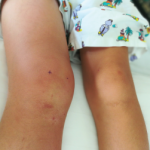For this patient, Ms. Kremer said trauma, septic arthritis, a bone tumor, inflammatory diseases, mechanical problems, infectious disease and hemarthrosis were all considered. Labs and imaging ruled out trauma, infection, tumor and other causes. Clinicians diagnosed the girl with oligoarticular JIA.
This disease is the most common subtype of JIA, making up 50% of cases, she said. Patients are typically female and present with a small number of swollen joints that are mostly in the lower extremities. Most patients are ANA positive and at high risk for eye inflammation.
The goal with treatment, clearly, is disease remission, Ms. Kremer noted. “This may require rapid medication escalation to gain adequate control. We want to prevent joint damage and maintain as much normal function as we can. And of course, we want to avoid medication toxicity,” she said.
Treatment options include triamcinolone acetonide injections, disease-modifying anti-rheumatic drugs (DMARDs), methotrexate, leflunomide, sulfasalazine and hydroxychloroquine.
For this patient, clinicians designed a treatment plan that included an intraarticular triamcinolone injection with 10 mg/kg per day of naproxen until the swelling and pain resolved. The dose of triamcinolone is 1–2 mg per kilogram per joint, depending on the size of the joint and the child, she said. The patient was prescribed physical therapy and asked to follow up in three months. If the knee swelling came back, clinicians planned to add a DMARD, possibly with another injection.
Additionally, because the girl was at a high risk for eye inflammation, she needed to undergo ophthalmology screening every three to four months.
Case 2: Another case involved a 15-year-old softball player who had right wrist and elbow pain that began during the previous softball season. She was experiencing increasing stiffness and trouble holding a toothbrush in the morning. She had no fevers or night sweats, no gastrointestinal symptoms and no pulmonary symptoms.
On exam, she had decreased wrist extension on both sides, decreased elbow extension, the inability to straighten her elbow and swelling in all of the small joints in her hands. She was anemic, positive for rheumatoid factor and ANA antibodies, and had elevated ESR and CRP levels.
In this case, the differential diagnosis included juvenile arthritis, lupus, dermatomyositis, vasculitis, scleroderma, inflammatory bowel disease, infections, immunologic or metabolic causes, malignancies, mechanical causes and pain syndromes.
A repeat test was also positive for rheumatoid factor, but the lab results did not meet the criteria for lupus. X-rays showed osteopenia of the MCP, PIP and DIP joints, with carpal crowding of the wrist and osteopenia of the distal, radial and ulnar joints.

